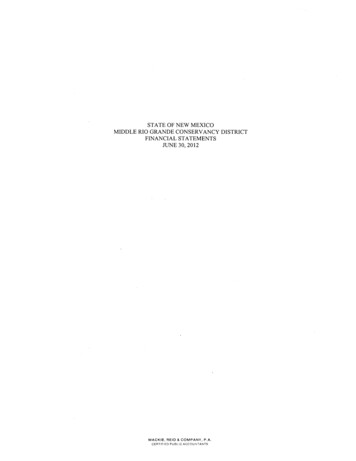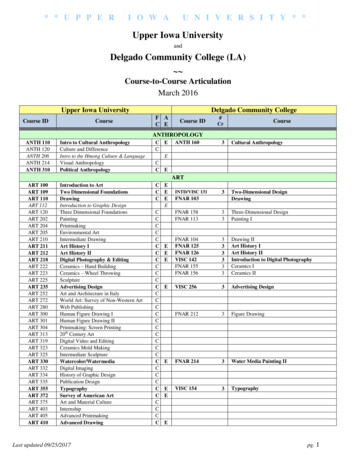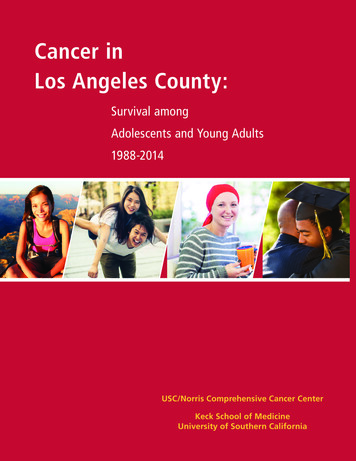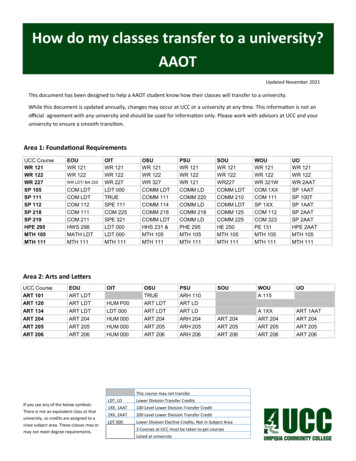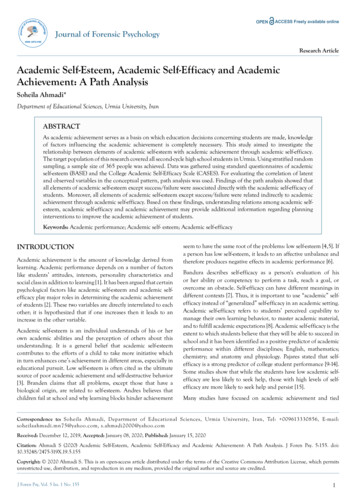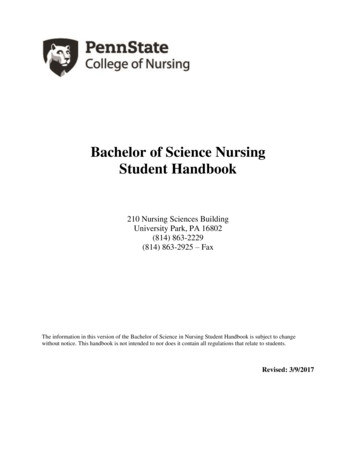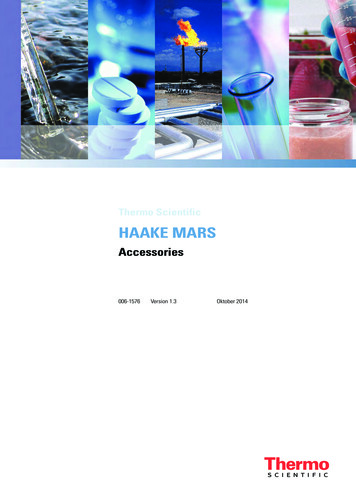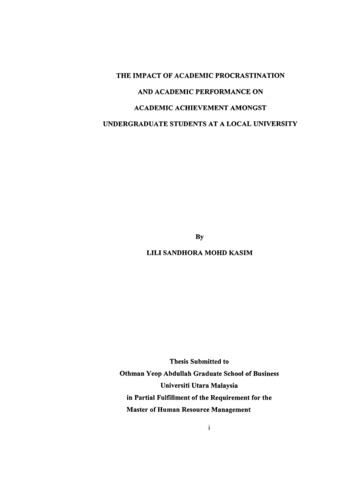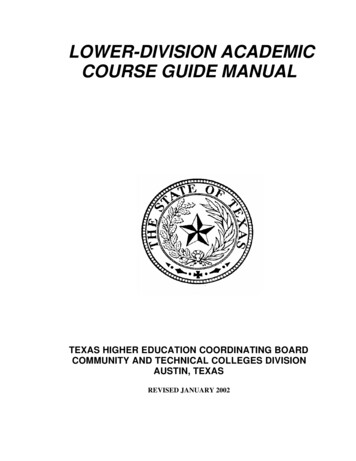
Transcription
LOWER-DIVISION ACADEMICCOURSE GUIDE MANUALTEXAS HIGHER EDUCATION COORDINATING BOARDCOMMUNITY AND TECHNICAL COLLEGES DIVISIONAUSTIN, TEXASREVISED JANUARY 2002
The Texas Higher Education Coordinating Boarddoes not discriminate on the basis of race, color,national origin, gender, religion, age, or disabilityin employment or the provision of services.
Standing Advisory Committee Roster 2000-2001Co-ChairsRichard BaileyVice President of InstructionSan Jacinto College – NorthPatricia McKenzieDean of InstructionAngelina CollegeBrian McKinneyDirector, Academic Programs ManagementUniversity of HoustonRobert NelsenProfessor of Literary and Aesthetic StudiesUniversity of Texas – DallasMembersJohn PartinDean of Academic InstructionGrayson County CollegeRebecca Anderson – Ex-OfficioCoordinator of Articulation ServicesTexas A&M University – Commerceand TCCNS Database AdministratorRay Williams – Ex-OfficioAcademic DeanTrinity Valley Community CollegeKeith BairdAssistant to the Director of AdmissionsUniversity of Texas at AustinKichoon YangAssistant Vice President for UndergraduateStudiesUniversity of Texas – Pan AmericanHansel BurleyProfessor of EducationTexas Tech UniversityRex PeeblesDean of Social & Behavioral SciencesAustin Community CollegeAnn Lopez – Ex-OfficioDean of Arts and SciencesDel Mar Community CollegeMary PlishkerAssociate Dean of Arts and SciencesSan Houston State UniversityVerna DeweesDirector of Academic Programsand Assistant Administrator of PlanningTexas A&M University SystemJean SchaakeAssociate Dean of Arts and SciencesUniversity of North TexasEmily HarboldAssociate Dean of Academic ProgramsTexas Woman’s UniversityMark TenglerArticulation/Transfer SpecialistHouston Community College SystemAlvin LarkeAssistant to the Provostand ProfessorTexas A&M UniversityCoordinating Board StaffJulie LeidigDirector of Instructional ProgramsCommunity and Technical College DivisionCarla WhittakerProfessor of BiologyBlinn CollegeDavid CouchAssistant Director of Instructional ProgramsCommunity and Technical College DivisionPaul MatneyDivision ChairLanguage, Communication and Fine ArtsAmarillo CollegeCatherine ParsoneaultProgram DirectorDivision of Universities and Health Related Institutionsi
LOWER-DIVISION ACADEMIC COURSE GUIDE MANUAL (REVISED 2001)TABLE OF CONTENTSStanding Advisory Committee Roster 2000-2001 .iIntroduction.1Changes in the ACGM.1The ACGM and the Academic Unique Need Inventory .1Instructions: How to Read and Use the ACGM .2The Texas Common Course Numbering System (TCCNS).4Addition and Deletion of Courses .4Unique Need Courses .6Distance Learning .7Developmental Courses .7List of Approved Courses .8ACCT (Accounting) .8AGRI (Agriculture) .8ANTH (Anthropology) .12ARCH (Architecture).13ARTS (Studio Art & Art History) .15BCIS (Business Computer Information Systems) .20BIOL (Biology) .24BUSI (Business) .28CHEM (Chemistry) .30CHIN (Chinese Language) .32COMM (Communication) .33COSC (Computer Science) .38CRIJ (Criminal Justice) .43CZEC (Czechoslovakian Language) .45DANC (Dance) .46DRAM (Drama) .52ECON (Economics) .55EDUC (Education) .56ENGL (English) .58ENGR (Engineering) .61ENVR (Environmental Science).63FREN (French Language).64GEOG (Geography) .65GEOL (Geology) .67GERM (German Language) .70GOVT (Government).71GREE (Greek Language).73HECO (Home Economics) .73HIST (History) .75HORT (Horticulture) .77HUMA (Humanities) .77ITAL (Italian Language).78JAPN (Japanese Language) .79ii
LOWER-DIVISION ACADEMIC COURSE GUIDE MANUAL (REVISED 2001)KINE (Kinesiology): See PHED Listings .79LATI (Latin Language) .80MATH (Mathematics) .80MUAP (Applied Music) .84MUEN (Music Ensemble) .85MUSI (Music ).86PHED (Physical Education) .93PHIL (Philosophy) .97PHYS (Physics) .100PORT (Portuguese Language).102PSYC (Psychology) .103REAL (Real Estate) .106RUSS (Russian Language) .106SGNL (American Sign Language) .107SOCI (Sociology) .107SOCW (Social Work) .110SPAN (Spanish Language) .110SPCH (Speech) .112TECA (Early Childhood Education) .115New Courses .116ARCH .116ARTS .116BCIS .116BIOL .116COSC.116CRIJ .116DANC .117DRAM .117EDUC .117ENGL.117ENGR .117ENVR .118GEOG .118GEOL.118KINE/PHED .118LATI .118MATH.118MUSI .119PHIL .119PSYC .119SGNL.119SPAN .119TECA.119Developmental Courses .120Study Skills .120Developmental Mathematics .120Intermediate Algebra .120Developmental Reading.121iii
LOWER-DIVISION ACADEMIC COURSE GUIDE MANUAL (REVISED 2001)Developmental Writing .121Developmental Composition for Non-Native Speakers .121Developmental ESOL Oral Communication.121Developmental ESOL Reading and Vocabulary.122Developmental ESOL Writing and Grammar .122Courses Under Review.123Deleted Courses.124BUSI .124DRAM .124ENGL.124HECO .124HIST .124Human Development .124MATH.124OFAD .125PSYC .125Developmental.125Courses Lacking TCCN Designations .126ART .126BIOLOGY .126ENGLISH .126HOME ECONOMICS.127MUSIC .127PHYSICAL EDUCATION .128Courses Not Eligible For Funding .129Appendix A: Approved Field of Study Curricula .131Field of Study Curriculum for Child Development/Early Childhood Education.132Field of Study Curriculum for Grade 4-8 Certification.133Field of Study Curriculum for Business .134Field of Study Curriculum for Music .136Appendix B: Forms .139Unique Need Course: Request For Approval Form .140Instructions for Requesting a Unique Need Course .141Distance Learning Standards .142Out-Of-State Credit Course Request .143Appendix C: Distance Education and Off-Campus Instruction .147Approval of Distance Education and Off-Campus Instructionat Public Colleges and Universities .146Appendix D: Core Curriculum.153Transfer & Field of Study Curricula Rules.154Assumptions and Defining Characteristics.163Appendix E: Funding Category .173Funding Category Names and Funding Codes .176iv
LOWER-DIVISION ACADEMIC COURSE GUIDE MANUAL (REVISED JANUARY 2002 )IntroductionThe Lower-Division Academic Course Guide Manual (ACGM) is the official list ofapproval numbers for general academic transfer courses that may be offered for statefunding by public community and technical colleges in Texas. Questions concerning thecontent or implementation of the procedures in this manual should be directed to:Dr. Julie LeidigDirector of Instructional ProgramsDivision of Community and Technical CollegesTexas Higher Education Coordinating BoardP.O. Box 12788Austin, Texas 78711-2788Phone: (512) 427-6315Email: leidigje@thecb.state.tx.usThe provisions for approval of general academic courses for state appropriations areoutlined in the Coordinating Board's Rules and Regulations, Chapter 5, Subchapter S.Accordingly, the Coordinating Board established an Academic Course Guide ManualReview Committee with equal representation from public community colleges and publicuniversities. This standing committee meets at least twice annually or more frequently asneeded to recommend to the Coordinating Board staff appropriate courses to be added to,revised, or deleted from the Academic Course Guide Manual (ACGM). The members ofthe Committee who contributed to this edition of the ACGM are listed at the beginning ofthis manual.CHANGES IN THE ACGMThe 2001 edition of the ACGM lists alphabetically by discipline the academic coursesthat are funded by the state for public community and technical colleges and aretransferable to public universities. (For information regarding workforce educationcourses and their transferability, see the Workforce Education Course Manual.) Thisedition incorporates all course additions and changes summarized in the Summer 2000Addendum to the Lower Division Academic Course Guide Manual. Course additionsinclude new courses incorporated into field of study curricula or otherwise needed toreflect new curriculum trends.THE ACGM AND THE ACADEMIC UNIQUE NEED INVENTORYThe 2001 ACGM serves as the generic academic course inventory for all community andtechnical colleges in Texas. Individual institutions are not required to maintain separategeneral academic course inventories. Courses listed in this manual may be offered andreported for funding without requesting approval from the Coordinating Board.If a community or technical college wishes to offer a course not listed here, or offer anACGM course for more credit or contact hours than listed, it must request approval forsuch a course on the basis of unique need. There are no provisions in the 2001 edition forspecial topics courses. A resulting inventory of Unique Need Courses is the onlyacademic inventory required of individual institutions. Colleges must continue to reportacademic courses according to instructions in the most recent edition of the Reportingand Procedures Manual for Public Community and Technical Colleges published by theEducational Data Center of the Coordinating Board. All "edits" of reports must be in1
LOWER-DIVISION ACADEMIC COURSE GUIDE MANUAL (REVISED JANUARY 2002)accordance with the ACGM and the individual institutions' Unique Need Courseinventories. The state will no t fund academic courses at community and technicalcolleges that are not listed either in the ACGM or on the college’s Academic UniqueNeed inventory.INSTRUCTIONS: HOW TO READ AND USE THE ACGMIn the previous edition of the ACGM, courses were listed in order of the 1990Classification of Instructional Programs (CIP) code used by the U.S. Department ofEducation. To make the manual easier to use, the 2001 edition is organizedalphabetically by academic disciplines currently taught at community and technicalcolleges. All common courses listed in the 2001 ACGM have been numbered tocorrespond to course numbers assigned by the Texas Common Course NumberingSystem (TCCNS).Where available, each entry begins with a list of common course prefixes and numbers;for course descriptions with no common numbers currently assigned, a content descriptor(for example, “Environmental Science”) is listed. Beneath the course list appears a linelisting the 10-digit approval number for the course, the matching content descriptor, andinformation about maximum semester credit hours (SCH) per student, maximum SCHper course, and maximum content hours per course. This information is underlined.Finally, a brief course description appears.For example:BIOL 1106BIOL 1107BIOL 1306BIOL 1307BIOL 1406BIOL 1407BIOL 1108BIOL 1109BIOL 1308BIOL 1309BIOL 1408BIOL 1409(lab, 1st semester, for Biology majors)(lab, 2nd semester, for Biology majors)(lecture, 1st semester, for Biology majors)(lecture, 2nd semester, for Biology majors)(lecture lab, 1st semester, for Biology majors)(lecture lab, 2nd semester, for Biology majors)(lab, 1st semester)(lab, 1st semester)(lecture, 1st semester)(lecture, 2nd semester)(lecture lab, 1st semester)(lecture lab, 2nd semester)26.0101.51 03 General BiologyFundamental principles of living organisms including physical and chemicalproperties of life, organization, function, evolutionary adaptation, and classification.Concepts of reproduction, genetics, ecology, and the scientific method are included.Approval Number . .26.0101.51 03Content Descriptor . General BiologyMaximum SCH per student . 8Maximum SCH per course . . . 4Maximum contact hours per course . . 96In this example, the 10-digit CIP approval number is 26.0101.5103. The first six digits ofthe approval number indicate subject matter and are based upon the CIP codes. TheCoordinating Board staff assigns the last four digits. The 7th and 8th digits further2
LOWER-DIVISION ACADEMIC COURSE GUIDE MANUAL (REVISED JANUARY 2002 )delineate course content, sequence, or approval category. The 9th and 10th digitsindicate the funding category.26.0101 is the CIP code for General Biology51 is the code for the content listed in the course description. The range for thesenumbers is typically 51 to 59. However, if a course is approved as a Unique NeedCourse (as opposed to general approval), the 7th digit will be a 9 instead of a 5. Ifa course is approved as a permanent unique need, the 7th digit will be a 7 insteadof a 5 or 9. If the course is approved for excessive credit and/or contact hours(more than allowed in the approved listing), the 7th digit will be an 8 instead of a5 or 9.03 is the current state funding code for biological sciences in public community andjunior colleges. These codes range from 01 to 26.A complete listing of the academic funding codes is contained in Appendix E.(IMPORTANT NOTE: The 2002 edition of the ACGM reflects new state funding codesadopted this year. Most of these codes will not match funding codes found in the 1996ACGM.)After the CIP descriptor, “General Biology,” the maximum hours per student, semestercredit hours (SCH) per course, and contact hours per course are listed:8is the maximum number of semester credit hours (SCH) per student for coursesapplicable toward an associate degree under this specific approval number. Inthis example, a college may allow students to take eight SCH of general biologycourses and count them toward an associate degree.4is the maximum number of semester credit hours per course under this specificapproval number. In this case, the maximum number is four. A college couldoffer a course under this approval number for four or fewer SCH, but not more.The college should award the SCH in proportion to the number of contact hours,type of instruction, and with regard to the assigned common course number.A traditional Biology (or any other discipline) lecture course offered for threecontact hours of lecture over a 16-week semester will earn three semester credithours and carry a "3" in the second digit of the common course number.Similarly, a traditional lecture/lab course offered for three contact hours of lectureand three contact hours of laboratory over a 16-week semester would earn foursemester credit hours and carry a "4" in the second digit of the common coursenumber. In general, one semester credit hour is awarded per one contact hour oflecture instruction and one semester credit hour is awarded per two to four contacthours of laboratory instruction.96 is the total maximum number of contact hours per course according to thisparticular approval number. Thus, a college can offer a course under the GeneralBiology approval number for 96 or fewer contact hours, but not more. In thisexample, a four SCH biology course can be offered for up to a maximum 963
LOWER-DIVISION ACADEMIC COURSE GUIDE MANUAL (REVISED JANUARY 2002)contact hours. During a regular 16-week semester, 96 contact hours in thisparticular course might be broken down into three hours of lecture per week andthree hours of lab per week or into other combinations that total 96 contact hours.In rare cases, no common courses have been identified for specific approval numbers.Approval numbers for religion courses, listed under the heading “RELI” in this manual,are an example. In such cases, the college may designate its own course prefixes andnumbers.THE TEXAS COMMON COURSE NUMBERING SYSTEM (TCCNS)The TCCNS is a cooperative effort among Texas community colleges and universities tofacilitate transfer of freshman and sophomore- level general academic courses.The TCCNS provides a shared, uniform set of course designations for students and theiradvisors to use in determining both course equivalency and degree applicability oftransfer credit on a statewide basis. When students transfer between two participatingTCCNS institutions, a course taken at the sending institution transfers as the coursecarrying, or cross-referenced with the same TCCNS designation at the receivinginstitution.For additional information about the TCCNS, consult the following web sites:The TCCNS Matrix Online (http://www.tccns.org/ccn/ ) is hosted by Texas A&MUniversity at Commerce. This web site contains a list of participating TCCNSinstitutions, the TCCNS taxonomy, the TCCNS history, and the TCCNS boardmembers. The site also contains the master list of the common courses offered inTexas. The list is organized by institu
Blinn College Paul Matney Division Chair Language, Communication and Fine Arts . colleges that are not listed either in the ACGM or on the college's Academic Unique Need inventory. . (lecture lab, 2nd semester, for Biology majors) BIOL 1108 (lab, 1st semester) BIOL 1109 (lab, 1st semester) BIOL 1308 (lecture, 1st semester) BIOL 1309 .
